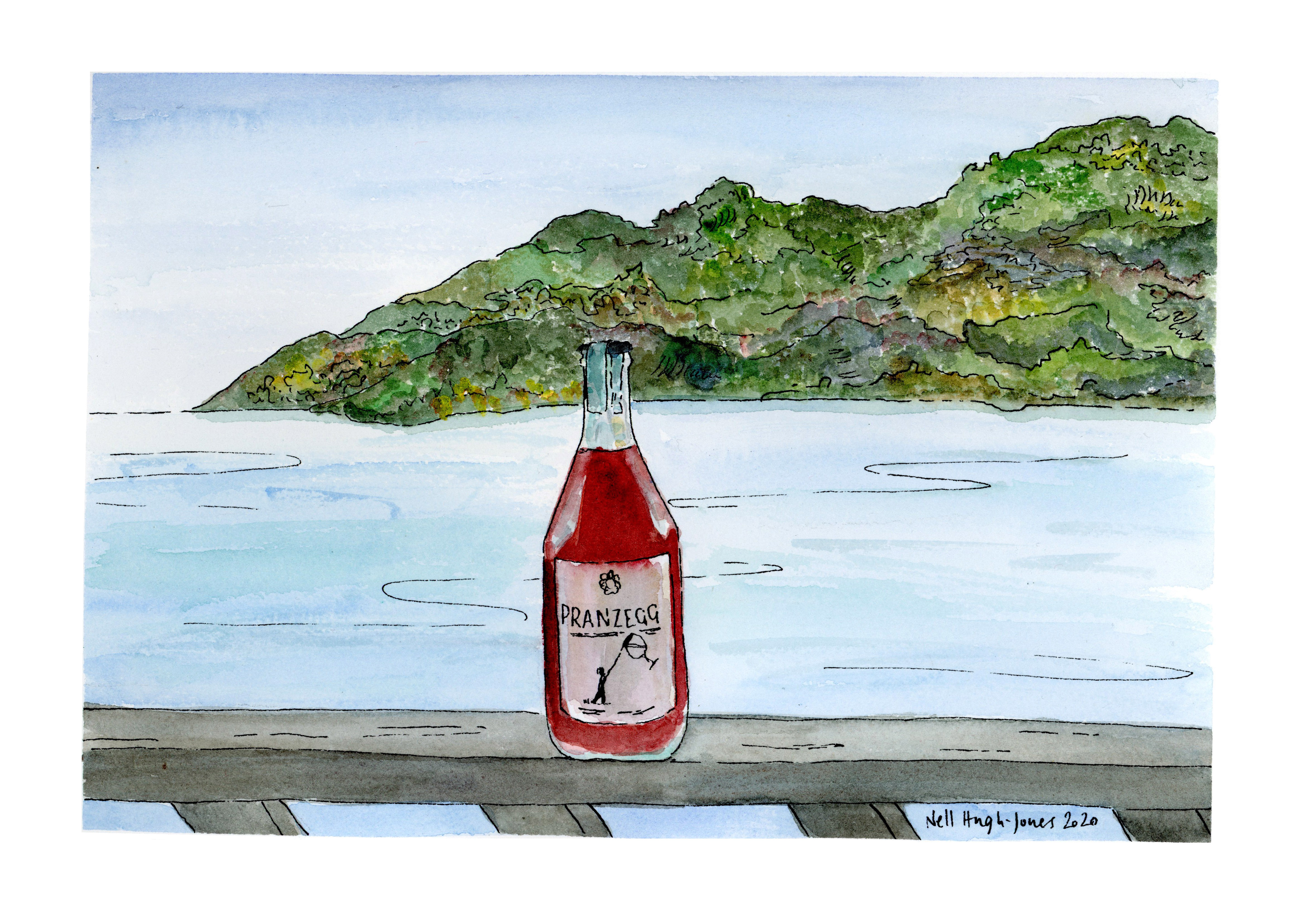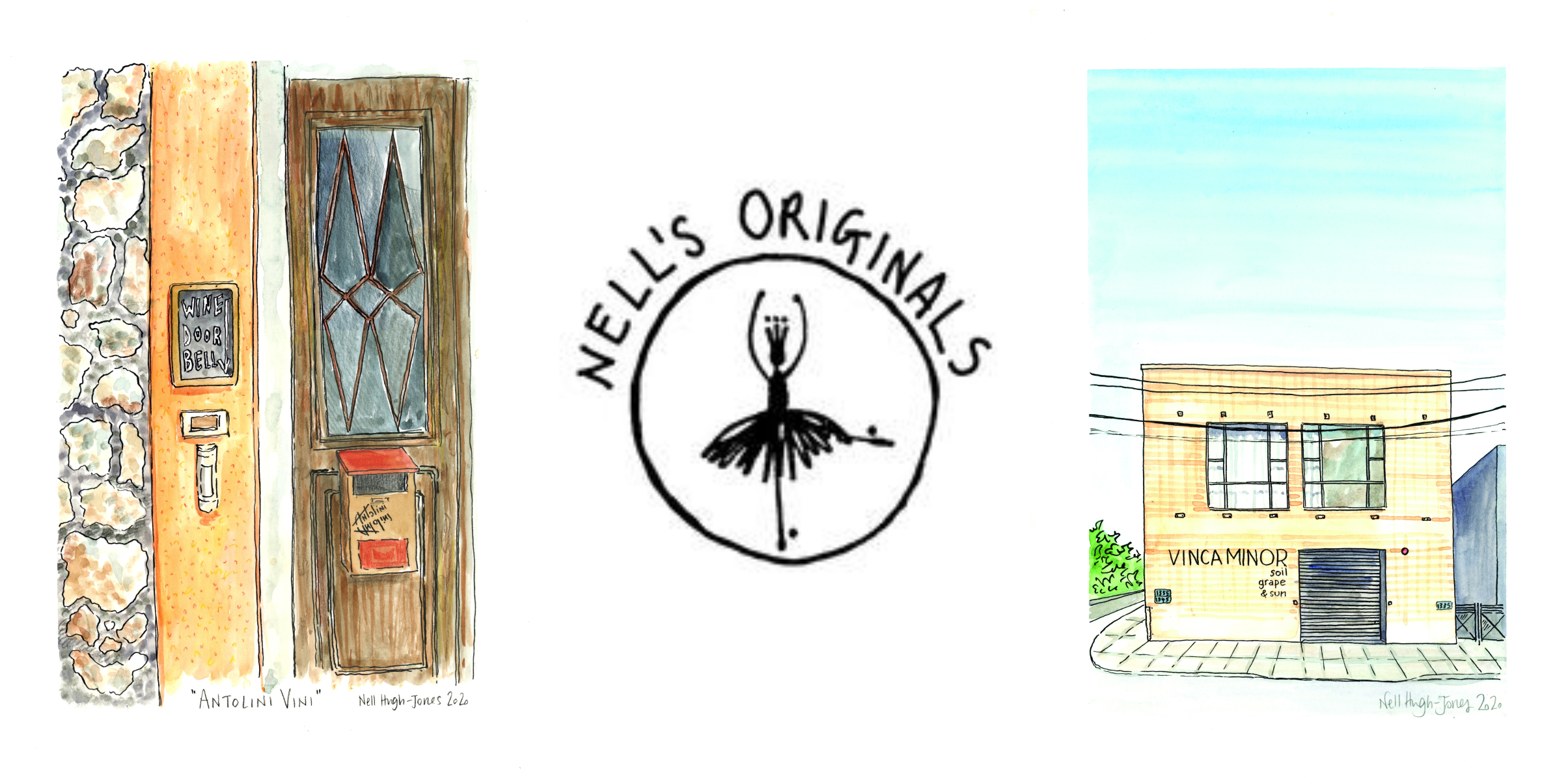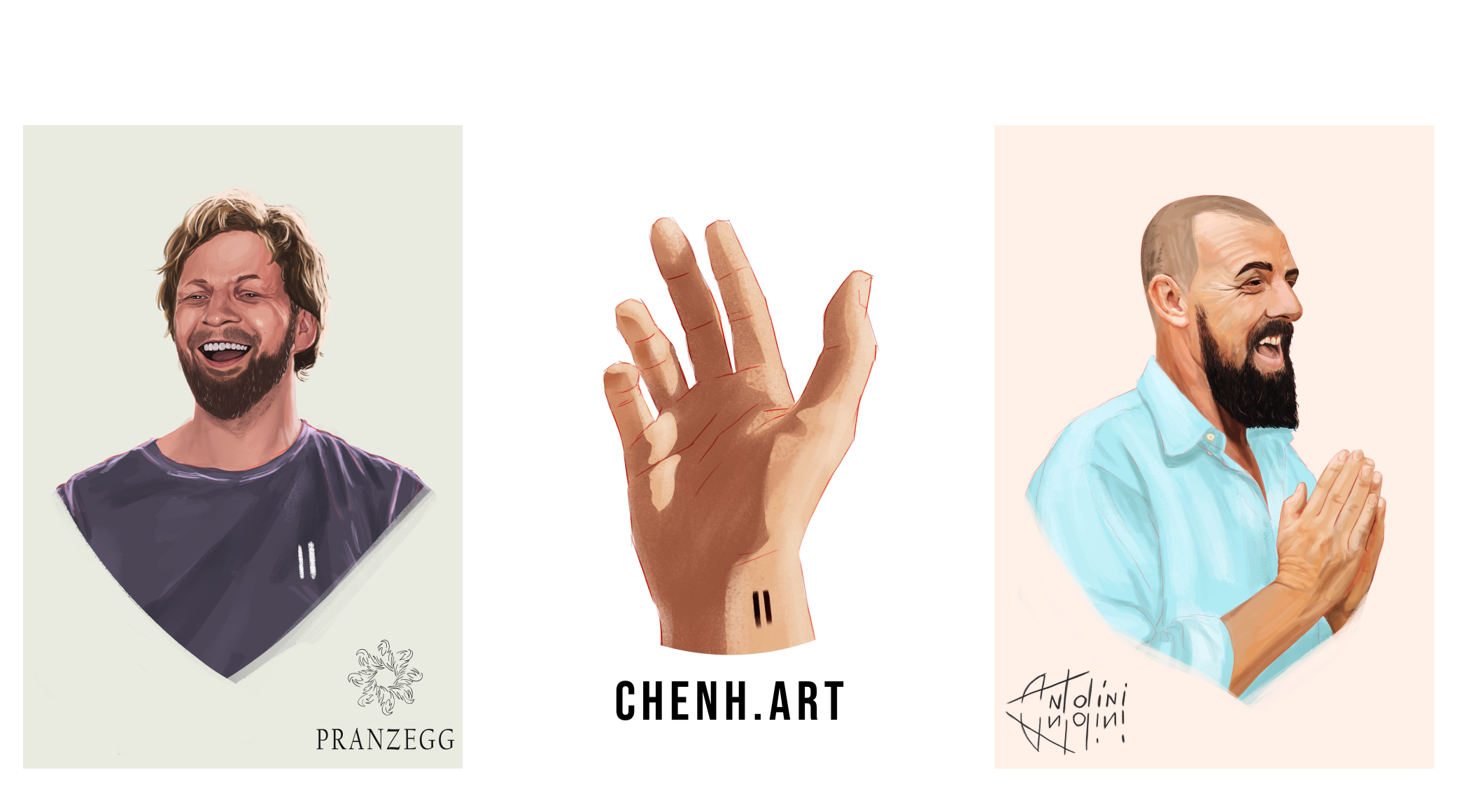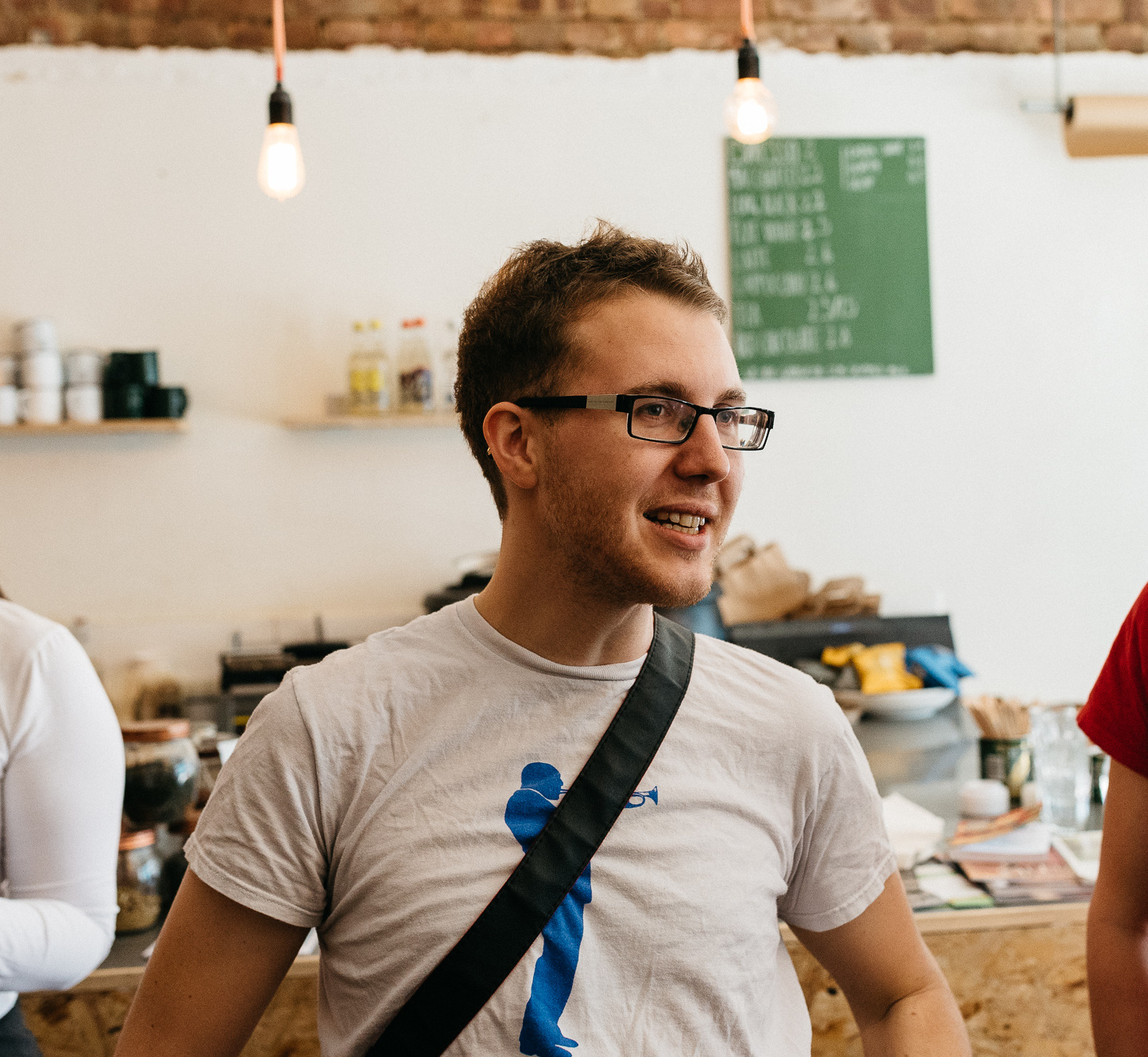For the second interview in this new series, we’re heading a little further north from the land of Valpolicella to explore the steep slopes of Südtirol (or Alto Adige), just outside Bolzano. In this northern-most part of Italy, famed for the glorious Dolomite mountain range, the border lines with Austria get a bit blurry – over 60% of the population speak German, compared to around 23% that speak Italian. If you are lucky you might meet someone who speaks Ladin!
This alpine wine region has both hot summers and cold winters to contend with, and the often cool summer nights lead to some very interesting wines. Not least at Weingut Pranzegg, a family winery run by Martin Gojer and Marion Untersulzner. The farm has been in Martin’s family for three generations, and he took over proceedings and instigated biodynamic practices in 2008.
Our last bottle of Pranzegg Vino Rosso Leggero | Watercolour by Nell’s Originals
Order this print online here!
——————–
We dropped in last July on a scorching hot afternoon. After a whistle-stop sweaty tour of the pergola-trained vineyards and their cosy cellar, we sat down to taste and talk about their wines. A few large pours later, we tore ourselves away (with some bottles for the road) to keep our sunset date with the Seiser Alm. Rather than attempt to recount what was said at that table (something about cheese wine?- ask Martin), I got back in touch recently to see how they were getting on.
Video Player
00:00
00:00
Hey! I hope you are all safe and well – life on the farm looks very peaceful in your video! How is the current situation affecting you and your winery?
Strict regulations have been in place for two months in Italy, but we are in a fortunate situation, as we have been able to continue with our work; we can reach our vineyards around Bolzano and get what we need from the stores for our farm. We have never worked quite as well as we do now, with so much calm and efficiency. This makes us think – what is the meaning of our profession, being a farmer? However, the exchange with people is of course a key part of it – it makes our work more beautiful, colourful, meaningful.
It’s certainly making everyone think differently and discover things about themselves! Hopefully we can take some positives from it. You have a pretty secluded spot in the hills outside Bolzano – what are the pros and cons, or perhaps the unique challenges of wine-making in your location?
We have 2 hectares at our farm and 1.5 hectares (3 individual layers) on the other side of the city on the mountain. All of the vineyards are very steep, the altitudes start from 250 m and go up to 700 m above sea level. These different orientations are an advantage because the work can be divided well and the same work does not occur everywhere at the same time. It is good to change your perspective. We organise ourselves when we go to the vineyards, taking food with us so that we can spend the whole day there!
Martin Gojer | Created by Damon Chenh | Order this print online here
—————————–
How did you get into winemaking? Were there any particular winemakers that inspired you to go in a biodynamic direction, or did that come from your family?
For me, Martin, there was actually no alternative, because this is our family farm and my father died when I was 12 years old. As the only boy, I knew I had to take over the farm, so my thoughts never went in another direction.
I had the opportunity to visit and get to know Josko Gravner in my youth – I was very impressed by him. As for biodynamics, my former colleague and very good friend Philine Dienger, who now has a winery in Piedmont, influenced me fundamentally. She started to integrate the biodynamic preparations (#500 & #501) at Pranzegg. Now we’re at a point where we can do this ourselves on the farm, working a lot with compost and strengthening nature with nature.
(Matt : Read more about specific biodynamic preparations here involving manure buried in cow horns!)
"It’s a way of life for us. There is no other way." Martin Gojer
So much is being said and written lately about natural, organic and biodynamic viticulture. What is your approach?
We use biodynamic practices in the vineyard and work very minimally in the cellar; spontaneous fermentation, no temperature controls, targeted use of sulphur. That was and is still a path that takes a lot of experience; we observe the progress of the wines, and are always learning more about the ongoing process. Nature always gives us new situations to which we must choose how to react. It’s a way of life for us. There is no other way. We create our own world, and whilst we do not want to convert or preach to others, perhaps we can set an example.
It is positive that there is a lot of coverage of this type of cultivation and fermentation – the more that people discuss it, the more it becomes an accepted part of our culture. To understand it, it is necessary to engage with the matter, be it as a grower or a wine drinker.
(Matt: For a really clear introduction to natural, organic and biodynamic practices – click here)

Could you tell us a little about the pergola vine method, and why you like to use it?
This is a traditional method in our region, but a complex one. You have to fix the shoots to the wires again and again, and create a good foliage so that there is decent ventilation under the pergola roof. Many farmers have replaced the pergola with trellises, since they are simply easier to work with, even with machines. However, we think that the pergola has its advantage even on hot days because the leaf roof does not heat the floor as much.
What are the oldest vines you work with? And how do these differing ages of vines come across in the grapes / wine?
Our Vernatsch grapes on the farm have an average age of 50 years, and the oldest vines are around 90 years old. Very impressive! These old vines have fewer and smaller grapes, but they are very tasty. A nice combination emerges in the mixture with the younger ones.

You work with some interesting indigenous grapes that the average drinker might be unfamiliar with. Could you take us through some of those and their qualities?
We mostly work with the red indigenous varieties of Vernatsch (Schiava) and Lagrein, which we have been cultivating for centuries. They are rather different from one another; the Vernatsch grapes have very thin skins, with little acid and colour, whilst the Lagrein have a striking dark colour and high tannins. It is important to us to maintain these varieties. Both place high demands on the location and the winemaker. In our opinion, in order to keep these vines in balance and to grow them successfully, flair and sensitivity are required. The biodynamic way of working also helps here.
And how do you decide when to harvest?
What is the overall goal, what do you want to communicate, and what is the definition of ripeness? In our opinion, the time of harvest is of great importance to the quality of the wine. We adjust the time so that we harvest wine grapes and not table grapes. I.e. the grapes are sufficiently acidic and crisp, and don’t yet show the full aroma and sweetness. This should only develop in the course of the fermentation.
Are there particular vessels that you like to work with for certain wines?
We work with large used wood and concrete. Some of the wines remain in the barrels for over two years. We often ferment with the skins on, and the tannins need the time in barrel.

Let’s talk about those wines! It’s been pretty hot in London of late, and I’ve really been craving your Vino Rosso Leggero.
We love the Vino Rosso Leggero (a blend of Vernatsch, Lagrein & Merlot)! It is an easy drinking wine for everyone, but not banal! That’s it, that’s all. Open the bottle and empty it.
We did. Several times! We must buy more next time… Another Pranzegg wine that lives long in the memory is the extraordinary GT – not your average bottle of Gewurztraminer! Could you tell us a little more about this bottle?
Normally you would expect an aromatic variety like Gewurtztraminer, Malvasia, or Zibbibo to smell aromatic and taste sweet. But it can also have a different face. The exciting thing about our GT is that this aroma, coupled with dryness and tannins, leads to an overall picture that is even more attractive. We believe that this will make the wine more versatile and that it can also be better used as an accompaniment to food.
It was an extraordinary wine – we only managed a few days of resistance before we drank our only bottle in the Dolomites. N.B. Readers in the UK – both the GT and the Vino Rosso Leggero are available from Newcomer Wines.

How did the relationship with Newcomer Wines come about?
Peter Honegger and his partner Daniela Pillhofer (the owners of Newcomer Wines) went on vacation in South Tyrol and drank a bottle of Pranzegg Caroline in their hotel. After an additional tip from Claus Preisinger (a good friend of ours), they both came to visit us, tasted it and finally added the wines to the range!
I’m very glad that they did! Before we sign off, do you have any tips for anyone thinking of starting wine making?
Drink a lot of wine and visit many winegrowers: this is the best way to learn and to get an idea of what you want and what you don’t want!
Well I’m off to a good start then! Thanks so much for talking to us – I’m off to stock up on Vino Rosso Leggero.

For more info on Weingut Pranzegg, head to their website here : pranzegg.com
This is the second in a new series of interviews across the drinks industry – keep track of them in The People section, or sign up to the Matt The Latest newsletter at the bottom of this page. If you want to catch up, you can find the first interview with Pier Paolo Antolini of Antolini Vini here.
Thanks once again to Nell Hugh-Jones at Nell’s Originals and Damon Chenh at Chenh Art for creating bespoke artworks for this article. You can find these works and others in the series on sale alongside my prints on Matt The Prints:
MTL x Nell’s Originals // MTL x Chenh Art
Check them out and support independent artists by purchasing the prints!
Scroll down for more photos from our visit to Weingut Pranzegg!
Special thanks to Lauren for her German language assistance.





